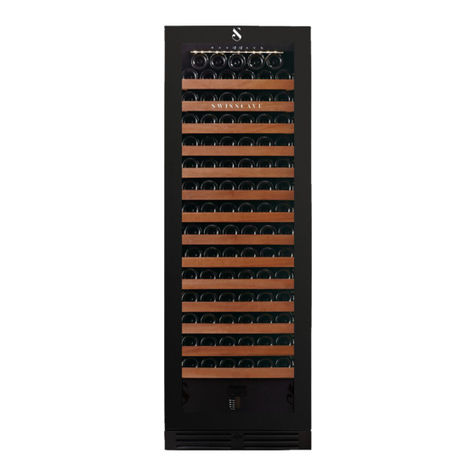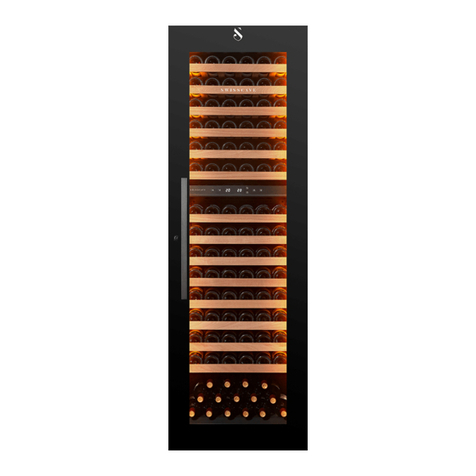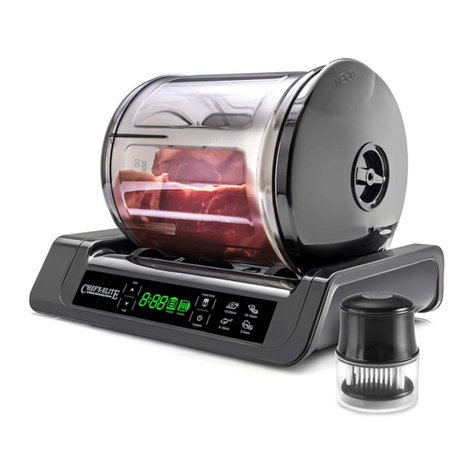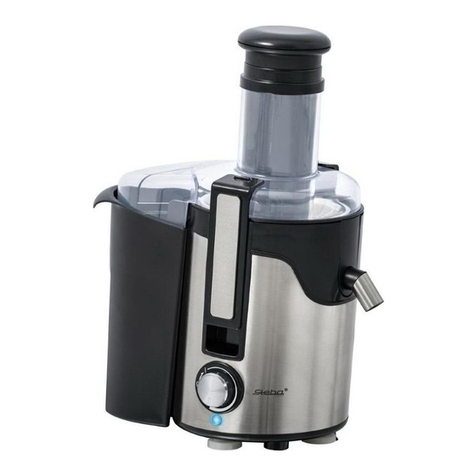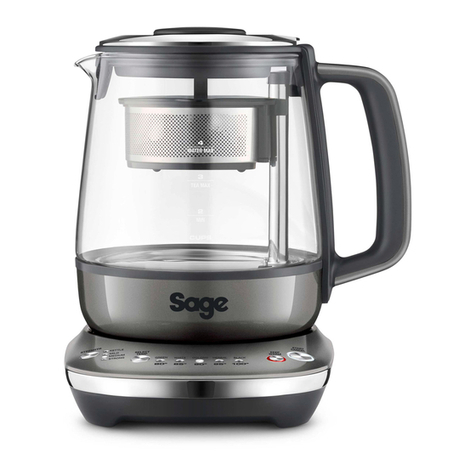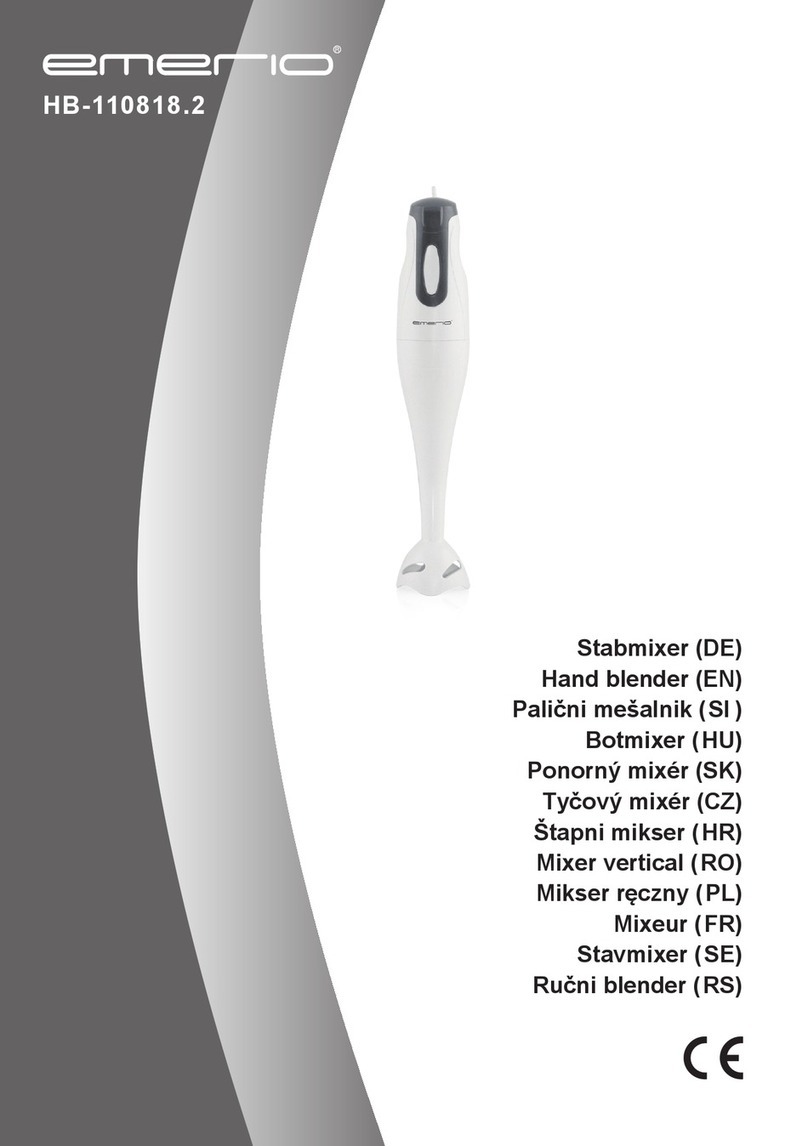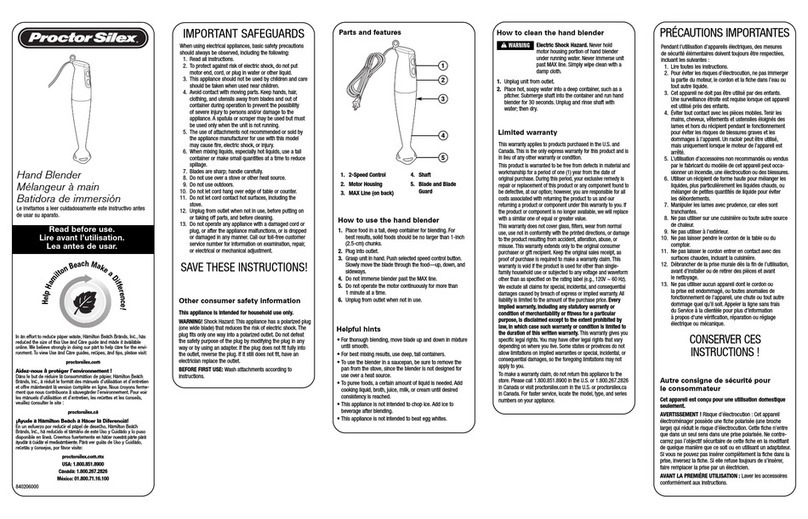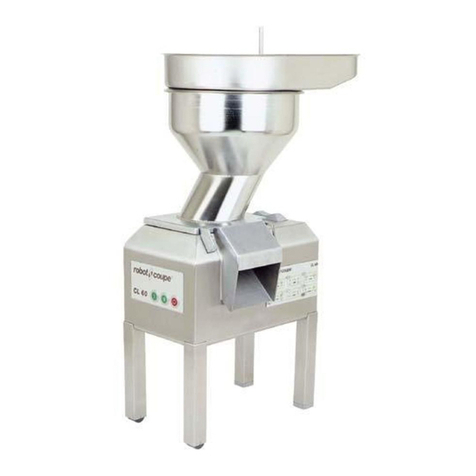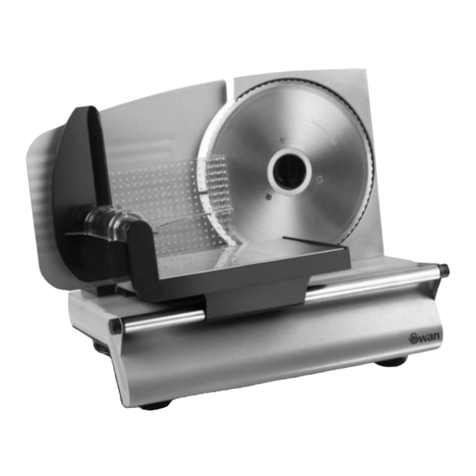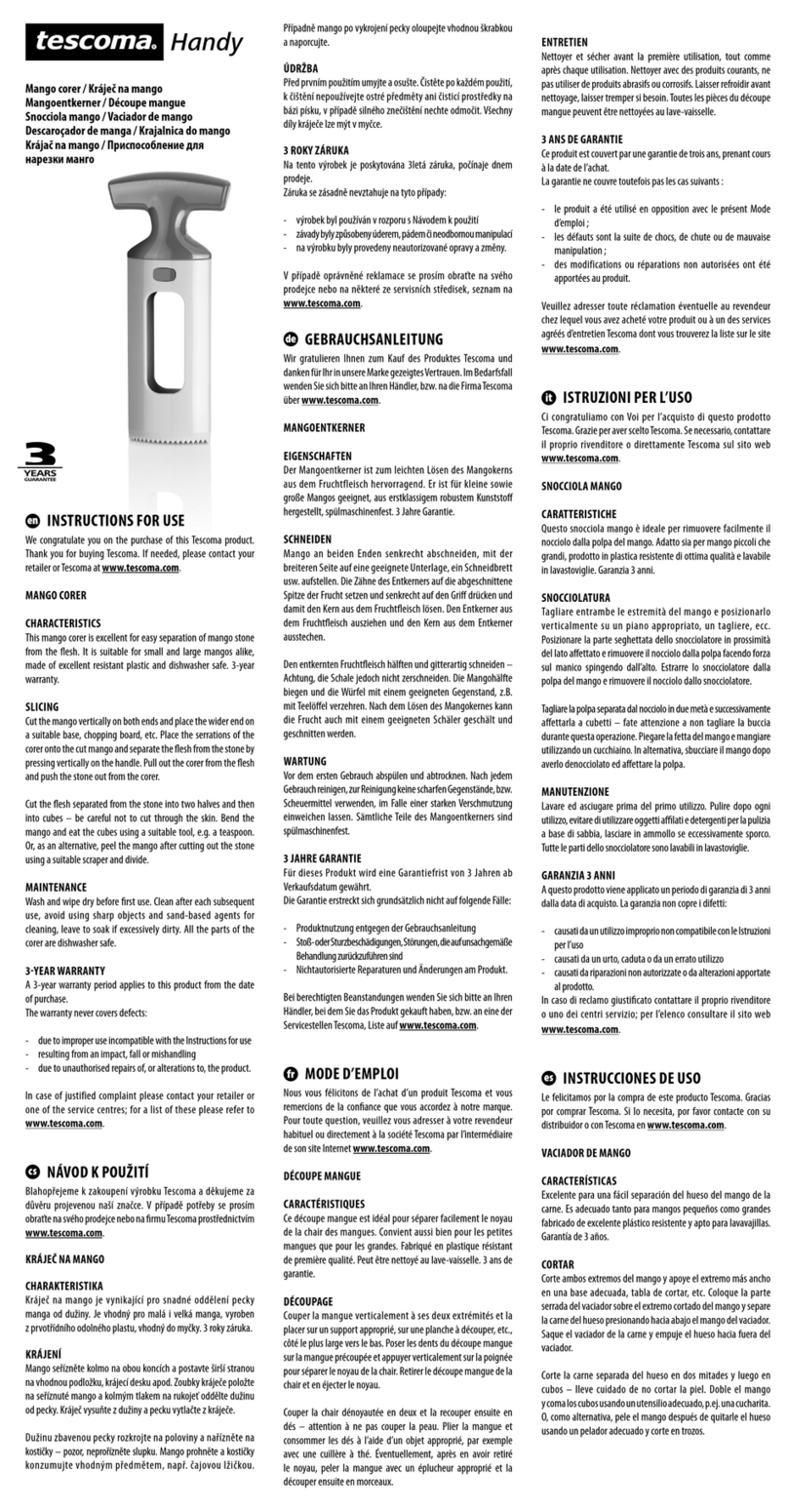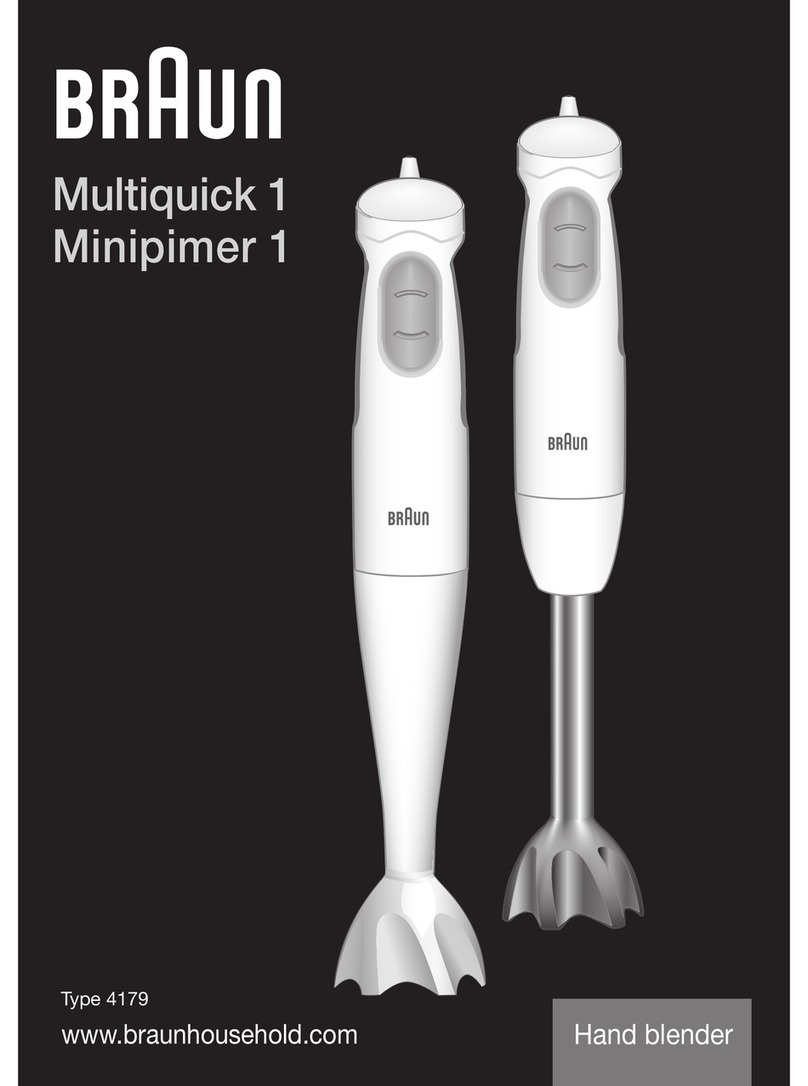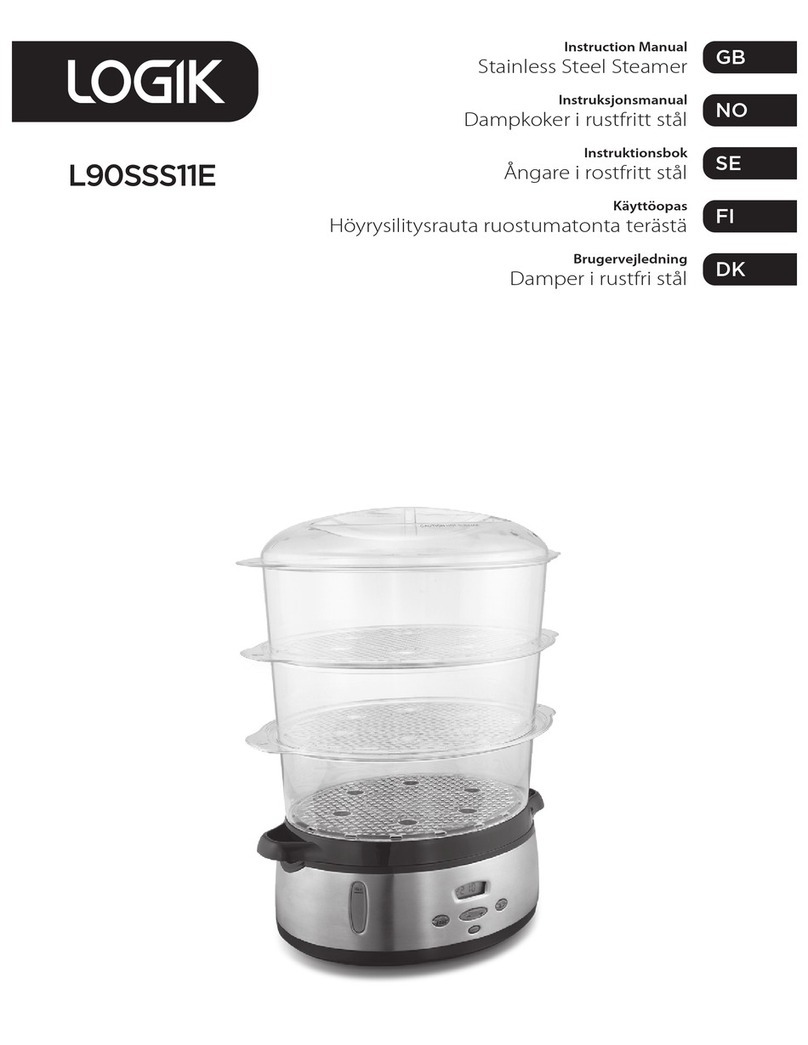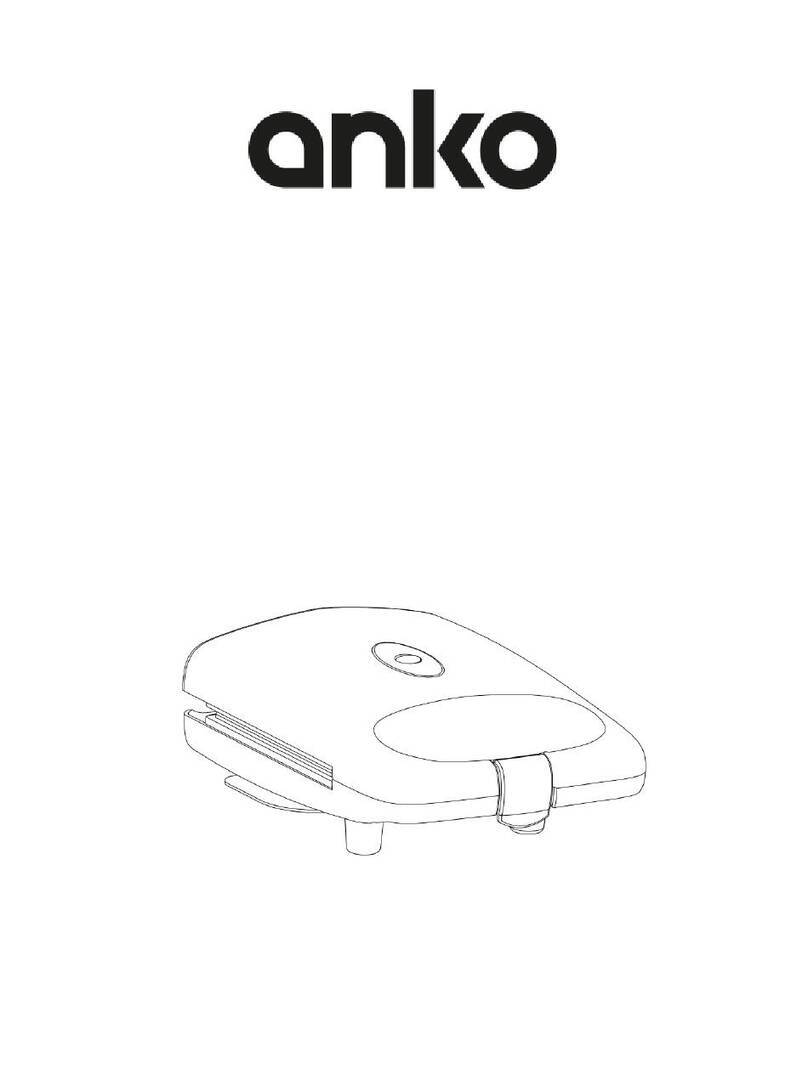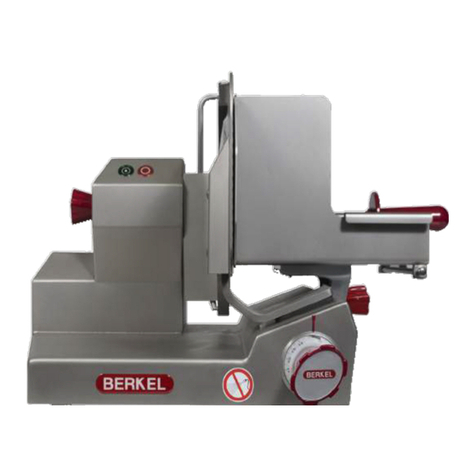SWISSCAVE Classic Edition WL1SSDF Series User manual

3
WEINKLIMASCHRANK
Bedienungsanleitung
WINE COOLING CABINET
User Manual
CAVES A VIN
Mode d'Emploi
FRIGORIFERI CANTINA


WL155DF SERIES
WL355DF SERIES
WL455DF SERIES
BEDIENUNGSANLEITUNG (DEUTSCH) 2
USER MANUAL (ENGLISH) 10
MODE D'EMPLOI (FRANÇAIS) 18
MANUALE DI ISTRUZIONE (ITALIANO) 26
Rev. 1.1

3
SWISSCAVE WL155 & WL455 SERIES
BEDIENUNGSANLEITUNG (DEUTSCH)
1 Gerätebeschreibung
2 Entsorgungshinweis
1. Das Gerät enthält wertvolle Materialien
und ist einer vom unsortierten
Siedlungsabfall getrennten Erfassung
zuzuführen. Die Entsorgung von
ausgedienten Geräten muss fach- und
sachgerecht nach den örtlich geltenden
Vorschriften und Gesetzen erfolgen.
2. Das ausgediente Gerät beim Abtransport
am Kältekreislauf nicht beschädigen, damit
das enthaltene Kältemittel (Angaben auf
dem Typenschild) und das Öl nicht
unkontrolliert entweichen können.
- Gerät unbrauchbar machen.
- Netzstecker ziehen.
- Anschlusskabel durchtrennen.
WARNUNG
Erstickungsgefahr durch
Verpackungsmaterial und Folien!
Kinder nicht mit
Verpackungsmaterial spielen
lassen.
Das Verpackungsmaterial zu einer
offiziellen Sammelstelle bringen.
3 Sicherheits- und Warnhinweise
•Um Personen- und Sachschäden zu vermeiden,
sollte das Gerät von zwei Personen ausgepackt
und aufgestellt werden.
•Bei Schäden am Gerät umgehend - vor dem
Anschließen - beim Lieferanten rückfragen.
•Zur Gewährleistung eines sicheren Betriebes
Gerät nur nach Angaben der
Gebrauchsanleitung montieren und anschließen.
•Im Fehlerfall Gerät vom Netz trennen.
Netzstecker ziehen oder Sicherung auslösen
bzw. herausdrehen.
•Nicht am Anschlusskabel, sondern am Stecker
ziehen, um das Gerät vom Netz zu trennen.
•Reparaturen und Eingriffe an dem Gerät nur vom
Kundendienst ausführen lassen, sonst können
erhebliche Gefahren für den Benutzer entstehen.
Gleiches gilt für das Wechseln der
Netzanschlussleitung.
•Im Geräteinnenraum nicht mit offenem Feuer
oder Zündquellen hantieren. Beim Transport und
beim Reinigen des Gerätes darauf achten, dass
der Kältekreislauf nicht beschädigt wird.
Beschädigungen Zündquellen fernhalten und
den Raum gut durchlüften.
•Sockel, Schubfächer, Türen usw. nicht als
Trittbrett oder zum Aufstützen missbrauchen.

3
•Dieses Gerät kann von Kindern ab 8 Jahren
und darüber sowie von Personen mit
verringerten physischen, sensorischen oder
mentalen Fähigkeiten oder Mangel an
Erfahrung und Wissen benutzt werden,
wenn sie beaufsichtigt oder bezüglich des
sicheren Gebrauchs des Gerätes
unterwiesen wurden und die daraus
resultierenden Gefahren verstehen. Kinder
dürfen nicht mit dem Gerät spielen.
Reinigung und Benutzer-Wartung dürfen
nicht von Kindern ohne Beaufsichtigung
durchgeführt werden.
•Vermeiden Sie dauernden Hautkontakt mit
kalten Oberflächen oder Kühl-/Gefriergut.
Es kann zu Schmerzen, Taubheitsgefühl
und Erfrierungen führen. Bei länger
dauerndem Hautkontakt sind
Schutzmaßnahmen vorsehen, zum Beispiel
Handschuhe verwenden.
•Verzehren Sie keine überlagerten
Lebensmittel, sie können zu einer
Lebensmittelvergiftung führen. Lagern Sie
keine explosiven Stoffe oder Sprühdosen
mit brennbaren Treibmitteln, wie z.B.
Propan, Butan, Pentan usw., im Gerät.
Eventuell austretende Gase könnten durch
elektrische Bauteile entzündet werden. Sie
erkennen solche Sprühdosen an der
aufgedruckten Inhaltsangabe oder einem
Flammensymbol.
•Keine elektrischen Geräte innerhalb des
Gerätes benutzen.
•Schlüssel bei abschließbaren Geräten nicht
in der Nähe des Gerätes sowie in
Reichweite von Kindern aufbewahren.
•Das Gerät ist für den Gebrauch in
geschlossenen Räumen konzipiert. Das
Gerät nicht im Freien oder im Feuchte- und
Spritzwasserbereich betreiben.
•Die LED-Lichtleisten im Gerät dienen der
Beleuchtung des Geräteinnenraumes. Sie
sind nicht zur Raumbeleuchtung geeignet.
•Beim Transport oder Betrieb des Gerätes
oberhalb von 1500 m Meereshöhe kann
durch den verminderten Luftdruck die
Glasscheibe der Tür zerbrechen. Die
Bruchstücke sind scharfkantig und können
schwere Verletzungen verursachen.
4 Einsatzbereich des Gerätes
Das Gerät eignet sich ausschließlich zum
Lagern von Wein und Zigarren (CLB Serie) im
häuslichen oder haushaltsähnlichen Umfeld.
Hierzu zählt z.B. die Nutzung
•in Personalküchen, Frühstückspensionen
•durch Gäste in Landhäusern, Hotels, Motels
und anderen Unterkünften,
•beim Catering und ähnlichem Service im
Großhandel.
Benutzen Sie das Gerät ausschließlich im
haushaltsüblichen Rahmen. Alle anderen
Anwendungsarten sind unzulässig. Das Gerät ist
nicht geeignet für die Lagerung und Kühlung von
Medikamenten, Blutplasma, Laborpräparaten
oder ähnlichen der Medizinprodukterichtlinie
2007/47/EG zu Grunde liegenden Stoffen und
Produkten. Eine missbräuchliche Verwendung
des Gerätes kann zu Schädigungen an der
eingelagerten Ware oder deren Verderb führen.
Im Weiteren ist das Gerät nicht geeignet für den
Betrieb in explosionsgefährdeten Bereichen.
5 Vor der Inbetriebnahme
1.Transport des Gerätes
ACHTUNG:
•SWISSCAVE Geräte dürfen nie gelegt werden.
•Beim Tragen zu zweit ist das Gerät diagonal zu
tragen: das heißt, dass die Person, welche die
Unterseite trägt, das Gerät am vorderen
Kühlgitter (unterhalb Tür) trägt, und dass diese
Person bei Treppen immer unten steht.
•Wenn das Gerät während der
Stockwerklieferung zwischendurch abgestellt
werden muss, nicht liegend, sondern immer
stehend abstellen.
2. Vermeiden Sie Standorte im Bereich direkter
Sonnenbestrahlung, neben Herd, Heizung und
dergleichen.
3. Stellen Sie den Klimaschrank auf eine stabile,
trockene und gerade Fläche. Der Schrank sollte
keinen Vibrationen, Stößen, Nässe oder Kälte
(unter Gefrierpunkt) ausgesetzt sein.

4
4. Der Aufstellungsraum Ihres Gerätes muss
laut der Norm EN 378 pro 8 g
Kältemittelfüllmenge R 600a ein Volumen
von 1 m3aufweisen, damit im Falle einer
Leckage des Kältemittelkreislaufes kein
zündfähiges Gas-Luft-Gemisch im
Aufstellungsraum des Gerätes entstehen
kann. Die Angabe der Kältemittelmenge
finden Sie auf dem Typenschild an der
Rückseite des Gerätes.
5. Das Gerät stets direkt an der Wand
aufstellen.
6. Mit den vorderen, verstellbaren Füssen
kann der Schrank so ausgerichtet werden,
dass er bei etwaigen Bodenunebenheiten
ganz senkrecht steht.
7. Nach definitiver Platzierung des
Klimaschranks diesen bitte während
mindestens 12 Stunden noch nicht am
Strom anschließen. Der Kompressor könnte
sonst beschädigt werden.
6 Energie sparen
•Immer auf gute Be- und Entlüftung achten.
Lüftungsöffnungen bzw. -gitter nicht
abdecken.
•Ventilatorluftschlitze immer freihalten.
•Gerät nicht im Bereich direkter
Sonnenbestrahlung, neben Herd, Heizung
und dergleichen aufstellen.
•Der Energieverbrauch ist abhängig von den
Aufstellbedingungen, zum Beispiel der
Umgebungstemperatur.
•Gerät möglichst kurz öffnen.
7 Klimaklasse
Die Klimaklasse gibt an, bei welcher
Raumtemperatur das Gerät betrieben werden
darf, um die volle Kälteleistung zu erreichen. Die
Klimaklasse ist am Typenschild aufgedruckt.
Klimaklasse Raumtemperatur
SN +10 °C bis +32 °C
N +16 °C bis +32 °C
ST +16 °C bis +38 °C
T +16 °C bis +43 °C
SN-ST +10 °C bis +38 °C
SN-T +10 °C bis +43 °C
Das Gerät nicht außerhalb der angegebenen
Raumtemperaturen betreiben!
8 Elektrischer Anschluss
•Das Gerät nur mit Wechselstrom
betreiben.
•Die zulässige Spannung und Frequenz ist
am Typenschild aufgedruckt.
•Die Steckdose muss vorschriftsmäßig
geerdet und elektrisch abgesichert sein.
•Der Auslösestrom der Sicherung muss
zwischen 10 A und 16 A liegen.
•Die Steckdose darf sich nicht hinter
dem Gerät befinden und muss leicht
erreichbar sein!
•Das Gerät nicht über Verlängerungskabel
oder Verteilersteckdosen anschließen.
•Keine Inselwechselrichter (Umwandeln
von Gleichstrom in Wechsel- bzw.
Drehstrom) oder Energiesparstecker
verwenden. Beschädigungsgefahr für die
Elektronik!

5
9 Gerätemaße
10 Bedien- und Kontrollelemente
Jede Funktion kann durch Berührung der
jeweiligen Taste aktiviert werden.
Ein-/Austaste (Gerät ein- und ausschalten)
Temperatureinstelltasten oberes Fach
Temperaturanzeige oberes Fach
Temperaturanzeige unteres Fach
Temperatureinstelltasten unteres Fach
Ein-/Austaste Innenbeleuchtung,
"C/F" Taste zur Umstellung der
Temperaturanzeige in "Celsius" oder
"Fahrenheit"
11 Gerät ein- und ausschalten
Einschalten
Taste drücken, so dass die
Temperaturanzeige leuchtet.
Ausschalten
Taste ca. 3 Sekunden drücken, so dass die
Temperaturanzeige dunkel ist.
12 Temperatur einstellen
Die Temperatur kann in beiden Fächern
unabhängig voneinander eingestellt werden.
Oberes Fach einstellbar von +10°C bis +20 °C
Unteres Fach einstellbar von +5°C bis +12°C.
Temperatur senken/kälter
Jeweils die Taste oder drücken.
Temperatur erhöhen/wärmer
Jeweils die Taste oder drücken.

6
•Beim ersten Tastendruck beginnt die Anzeige zu
blinken.
•Durch weiteres Drücken der Taste wird die
Temperatureinstellung verändert.
•Ca. 5 Sek. nach dem letzten Tastendruck
schaltet die Elektronik automatisch um und die
tatsächliche Temperatur wird angezeigt.
Folgende Trinktemperaturen sind für die
verschiedenen Weinsorten empfehlenswert.
Rotwein: +14 °C bis +18 °C
Roséwein: +10 °C bis +12 °C
Weißwein: +8 °C bis +12 °C
Sekt, Champagner: +7 °C bis +12 °C
Zur langfristigen Lagerung von Weinen wird eine
Temperatur von +10 °C bis +12 °C empfohlen.
13 Einlagerungsskizzen für 0,75 l
Bordeaux-flaschen
14 Reinigung
Vor dem Reinigen grundsätzlich das Gerät
außer Betrieb setzen. Netzstecker ziehen
oder die vorgeschaltete Sicherung auslösen
bzw. herausschrauben.
•Innenraum und Außenwände mit lauwarmem
Wasser und etwas Spülmittel reinigen.
Verwenden Sie keinesfalls sand- oder
säurehaltige Putz- bzw. chemische
Lösungsmittel.
•Verwenden Sie zur Reinigung der Glasflächen
einen Glasreiniger, für Edelstahlflächen einen
handelsüblichen Edelstahlreiniger.
Nicht mit Dampfreinigungsgeräten arbeiten!
Beschädigungs- und Verletzungsgefahr.
•Achten Sie darauf, dass kein Reinigungswasser
in die elektrischen Teile und in das Lüftungsgitter
dringt.
•Das Typenschild an der Geräteaußenseite nicht
beschädigen oder entfernen - es ist wichtig für
den Kundendienst.
15 Außer Betrieb setzen
Wenn das Gerät längere Zeit außer Betrieb
gesetzt wird: Gerät ausschalten, Netzstecker
ziehen oder die vorgeschalteten Sicherungen
auslösen bzw. herausschrauben.
Gerät reinigen und die Tür geöffnet lassen, um
Geruchsbildung zu vermeiden.
Auszugstablare mit einem Pflegeöl oder sanften
Holzwachs behandeln
Gerät auf stabilen, nicht wackeligen oder
rutschigen Boden abstellen
Das Gerät entspricht den einschlägigen
Sicherheitsbestimmungen sowie den EG-
Richtlinien 2004/108/EG und 2006/95/EG.

7
16 Störung
•Im Anzeigedisplay erscheint E1, E2, E3, E4,
E5, E6, HH oder LL
Am Gerät liegt ein Fehler vor. Den
Kundendienst kontaktieren.
Folgende Störungen können Sie durch
Prüfen der möglichen Ursachen selbst
beheben.
•Das Gerät arbeitet nicht. Prüfen Sie, ob
das Gerät eingeschaltet ist,
der Netzstecker richtig in der Steckdose ist,
die Sicherung der Steckdose in Ordnung ist.
•Beim Einstecken des Netzsteckers läuft das
Kälteaggregat nicht an, in der
Temperaturanzeige wird jedoch ein Wert
angezeigt.
Der Präsentationsmodus ist aktiviert. Den
Kundendienst kontaktieren.
•Die Geräusche sind zu laut. Prüfen Sie, ob
das Gerät fest auf dem Boden steht,
nebenstehende Möbel oder Gegenstände
vom laufenden Kühlaggregat in Vibrationen
gesetzt werden. Beachten Sie, dass
Strömungsgeräusche im Kältekreislauf nicht
zu vermeiden sind.
•Die Temperatur ist nicht ausreichend tief.
Prüfen Sie
die Einstellung nach Abschnitt
„Temperatur einstellen“, wurde der
richtige Wert eingestellt?
ob das separat eingelegte Thermometer
den richtigen Wert anzeigt.
Ist die Entlüftung in Ordnung?
Ist der Aufstellort zu dicht an einer
Wärmequelle?

8
17 Türumbandung
1 Benutze ein kleines Messer ②, um die dekorativen
Knöpfe ①zu lösen. (Bild 1)
2 Benutze einen Schraubendreher ③, um die
Schrauben ④der Fußblende zu lösen. (Bild 2-1)
3 Benutze den Schraubendreher ③, um die
Schrauben ⑤an beiden Seiten der Fußblende zu
lösen. (Bild 2-2)
4 Die Fußblende ⑥durch gleichmäßiges Ziehen
entnehmen. (Bild 2-3)
5 Benutze den Schraubendreher ③, um die
freiliegenden Schrauben zu lösen. (Bild 2-4)
6 Halte die Tür und benutze ein Sechskant-
Schraubendreher ⑧, um die oberen und unteren
Befestigungsschrauben zu lösen. Entnehme die
Tür und stelle sie zur Seite. (Bild 3)
7 Benutze den Sechskant-Schraubendreher ⑧,
um die Schrauben der Türangel ⑩und die
Türgelenke ⑾zu lösen. (Bild 4)
8 Entnehme die Türgelenke ⑾mit einem M5
Sechskant-Schraubendreher und befestige Sie
an die andere Seite. (Bild 5)
9 Drehe die Tür um 180° und schraube sie mit den
Befestigungsschrauben fest. (Bild 6)
10 Befestige die dekorativen Knöpfe ①an die
freiliegende Seite und befestige die Fußblende.
(Bild 7)
Produktanpassungen sind im Sinne eines verbesserten Produktes möglich – Änderungen vorbehalten, alle Angaben
ohne Gewähr.

DATENBLATT FÜR HAUSHALTSWEINTEMPERIERSCHRÄNKE
nach delegierter Verordnung (EU) Nr. 1060/2010
Marke SWISSCAVE
Modellname / -kennzeichen WL455DF
Haushaltskühlgerätekategorie
(1) 2
Energieeffizienzklasse
G
jährlicher Energieverbrauch (AEC)
(2) 172 kWh/Jahr
Nutzinhalt, Kühlfach gesamt
379 l
davon Kaltlagerfach
-
davon Weinlagerfach
379 l
davon Kellerfach -
Anzahl Flaschen gesamt
(3) 166
Niedrigste Lagertemperatur Weinlagerfach
+ 5 °C
Klimaklasse (4) SN
Luftschallemission
dB(A) re 1 pW
Bauform Stand
Marke SWISSCAVE
Modellname / -kennzeichen WL355DF
Haushaltskühlgerätekategorie
(1) 2
Energieeffizienzklasse
G
jährlicher Energieverbrauch (AEC)
(2) 160 kWh/Jahr
Nutzinhalt, Kühlfach gesamt
261 l
davon Kaltlagerfach
-
davon Weinlagerfach
261 l
davon Kellerfach -
Anzahl Flaschen gesamt
(3) 114
Niedrigste Lagertemperatur Weinlagerfach
+ 5 °C
Klimaklasse (4) SN
Luftschallemission 49dB(A) re 1 pW
Bauform Stand
Marke SWISSCAVE
Modellname / -kennzeichen WL155DF
Haushaltskühlgerätekategorie
(1) 2
Energieeffizienzklasse
G
jährlicher Energieverbrauch (AEC)
(2) 155 kWh/Jahr
Nutzinhalt, Kühlfach gesamt
119 l
davon Kaltlagerfach
-
davon Weinlagerfach
119 l
davon Kellerfach -
Anzahl Flaschen gesamt
(3) 39
Niedrigste Lagertemperatur Weinlagerfach
+ 5 °C
Klimaklasse (4) SN
Luftschallemission 39dB(A) re 1 pW
Bauform Stand
Diese Geräte sind ausschließlich zur Lagerung von Wein bestimmt.
Erklärungen:
(1) Haushaltskühlgeräte-Kategorien:
1=Kühlschrank mit einem oder mehreren Lagerfächern für frische Lebensmittel
2=Kühlschrank mit Kellerzone, Kellerfach-Kühlger.t und Weinschrank
3=Kühlschrank mit Kaltlagerzone und Kühlschrank mit einem Null-Sterne-Fach
4=Kühlschrank mit einem Ein-Sterne-Fach
5=Kühlschrank mit einem Zwei-Sterne-Fach
6=Kühlschrank mit einem Drei-Sterne-Fach
7=Kühl-Gefriergerät
8=Gefrierschrank
9=Gefriertruhe
10=Mehrzweck-Kühlgeräte und sonstige Kühlgeräte
(2) Auf der Grundlage von Ergebnissen der Normprüfung über 24 Stunden. Der tatsächliche Verbrauch hängt von der Nutzung und
vom Standort des Geräts ab.
(3) Angabe der Nennkapazität als Zahl der Standardflaschen von 0,75 l, die gemäß den Herstelleranweisungen im Gerät gelagert
werden können.
(4) Klimaklasse
SN: Dieses Gerät ist für den Betrieb bei einer Umgebungstemperatur zwischen + 10°C und +32°C bestimmt
N: Dieses Gerät ist für den Betrieb bei einer Umgebungstemperatur zwischen + 16°C und +32°C bestimmt
ST: Dieses Gerät ist für den Betrieb bei einer Umgebungstemperatur zwischen + 16°C und +38°C bestimmt
T: Dieses Gerät ist für den Betrieb bei einer Umgebungstemperatur zwischen + 16°C und +43°C bestimmt
39

11
SWISSCAVE WL155 & WL455 SERIES
USER MANUAL (ENGLISH)
1 Description of the appliance
2 Disposal notes
1. The appliance contains reusable
materials and should be disposed of
properly – not simply with unsorted
household refuse. Appliances which are no
longer needed must be disposed of in a
professional and appropriate way, in
accordance with the current local
regulations and laws.
2. When disposing of the appliance, ensure
that the refrigerant circuit is not damaged to
prevent uncontrolled escape of the
refrigerant it contains (data on type plate)
and oil.
- Disable the appliance.
- Pull out the mains plug.
- Cut through the connection cable.
WARNING
Danger of suffocation due to
packing material and plastic film!
Do not allow children to play with
packaging material. Take the
packaging material to an official
collection point.
3 Safety instructions and warnings
•To prevent injury or damage to the unit, the
appliance should be unpacked and set up by two
people.
•If the appliance is damaged on delivery, contact
the supplier immediately before connecting to the
mains.
•To guarantee safe operation, ensure that the
appliance is set up and connected as described
in these operating instructions.
•Disconnect the appliance from the mains if any
fault occurs. Pull out the plug, switch off or
remove the fuse.
•When disconnecting the appliance, pull on the
plug, not on the cable.
•Any repairs and work on the appliance should
only be carried out by the customer service
department, as unauthorised work could prove
highly dangerous for the user. The same applies
to changing the mains power cable.
•Do not allow naked flames or ignition sources to
enter the appliance. When transporting and
cleaning the appliance, ensure that the
refrigerant circuit is not damaged. In the event of
damage, make sure that there are no ignition
sources nearby and keep the room well
ventilated.

4
•Do not stand on the plinth, drawers or doors
or use them to support anything else.
•This appliance can be used by children of 8
years old and over, and also by persons with
restricted physical, sensory or mental
capacity or lack of experience and
knowledge, if they are supervised or have
been instructed on safe use of the appliance
and understand the resulting risks. Children
must not be allowed to play with the
appliance. Cleaning and user maintenance
must not be carried out by children without
supervision.
•Avoid prolonged skin contact with cold
surfaces or chilled/frozen food. This could
cause pain, numbness and frostbite. In the
case of prolonged skin contact, protective
measures should be taken, e.g. gloves
should be worn.
•Do not consume food which has been
stored for too long, as it could cause food
poisoning.
•Do not store explosives or sprays using
combustible propellants such as butane,
propane, pentane, etc. in the appliance.
Electrical components might cause leaking
gas to ignite. You may identify such sprays
by the printed contents or a flame symbol.
•Do not use electrical appliances inside the
appliance.
•If you have a lockable appliance, do not
keep the key near the appliance or within
reach of children.
•The appliance is designed for use in
enclosed areas. Do not operate the
appliance outdoors or in areas where it is
exposed to splash water or damp
conditions.
•The LED light strips illuminate the interior of
the appliance. They are not suitable for
lighting a room.
•When transporting or operating the
appliance at an altitude of more than 1500
m above sea level, the glass pane in the
door can break due to the reduction in air
pressure. Broken fragments are sharp-
edged and can cause serious injury.
4 Range of appliance use
The appliance is suitable solely for storing wine
and cigars (CLB series) in a domestic
environment or similar.
This includes, for example, use
•in staff kitchenettes, bed and breakfast
establishments,
•by guests in cottages, hotels, motels and other
forms of accommodation,
•in catering and similar services in the wholesale
trade.
Use the appliance solely as is customary within
a domestic environment. All other types of use
are inadmissible. The appliance is not suitable
for storing and cooling medicines, blood plasma,
laboratory preparations or similar substances
and products covered by the 2007/47/EC
Medical Devices Directive. Any misuse of the
appliance may result in damage to or spoilage of
stored goods. Furthermore, the appliance is not
suitable for operation in potentially explosive
atmospheres.
5 Before Commissioning
1.Transportation of cooling cabinet
ATTENTION:
•SWISSCAVE devices cannot be laid down.
•The devices are to be carried diagonally. That
means that the person carrying the underside
carries the device on its front grid (below the
doors) and that when negotiating stairs this
person always stands the lower.
•If the device must be temporarily set down then
this it should be stood straight up, and not placed
on its side.
2. Avoid positioning the appliance in direct sunlight
or near cookers, radiators and similar sources of
heat.

5
3. Place the device on a firm, dry and plain-
level surface. The cabinet should not be
exposed to temperatures below freezing
point, nor to vibrations, pushes or wet
environment.
4. Standard EN 378 specifies that the room in
which you install your appliance must have
a volume of 1 m3 per 8 g of R 600a
refrigerant used in the appliance, so as to
avoid the formation of inflammable gas/air
mixtures in the room where the appliance is
located in the event of a leak in the
refrigerant circuit. The quantity of refrigerant
used in your appliance is indicated on the
type plate on the inside of the appliance.
5. Always install the appliance directly against
the wall.
6. With the front levelling screws the cabinet
can be plain levelled so that it stands
completely straight, even if there is any
unevenness in the floor.
7. After definitive placement of the cooling
cabinet it should not be connected to power
for the duration of at least 12 hours. The
compressor may be damaged if this
instruction isn’t followed.
6 Saving energy
•Always ensure good ventilation. Do not
cover ventilation openings or grille.
•Always keep fan slits clear.
•Avoid positioning the appliance in direct
sunlight or near cookers, radiators or similar
sources of heat.
•The energy consumption depends on the
installation conditions, e.g. the ambient
temperature.
•Keep the time the appliance is open to a
minimum.
7 Climate rating
The climate rating indicates the room
temperature at which the appliance may be
operated in order to achieve full refrigeration
performance. The climate rating is indicated on
the type plate.
Climate rating Room temperature
SN +10 °C to +32 °C
N +16 °C to +32 °C
ST +16 °C to +38 °C
T +16 °C to +43 °C
SN-ST +10 °C to +38 °C
SN-T +10 °C to +43 °C
Do not operate the appliance outside the
specified room temperature range!
8 Electrical connection
•Only operate the appliance with alternating
current (AC).
•The permissible voltage and frequency are
indicated on the type plate. The position of the
type plate is shown in the section entitled
Description of the appliance.
•The socket must be properly earthed and
protected by a fuse.
•The tripping current of the fuse must be between
10 A and 16 A.
•The socket must not be situated behind the
appliance and must be easily accessible!
•Do not connect the appliance using an extension
cable or extension socket.
•Do not use stand-alone inverters (conversion of
direct current to alternating/three-phase current)
or energy-saving plugs. Risk of damage to the
electronic control system!

6
9 Appliance dimensions
10 Operating and control elements
Any function can be activated by touching the
corresponding button.
On/Off button (switching the appliance on/off)
Temperature setting buttons upper compartment
Upper compartment temperature display
Lower compartment temperature display
Temperature setting buttons lower compartment
Interior light On/Off button, "C/F" switch for
temperature display in "Celsius" or "Fahrenheit
11 Switching the appliance on and off
Switching the appliance on
Press button until the temperature display
lights up.
Switching the appliance off
Keep button pressed for approx. 3 seconds so
that the temperature display goes out.
12 Setting the temperature
The temperature of both compartments can be
set separately.
Temperature can be set at between +10 °C
and +20 °C
Temperature can be set at between +5 °C and
+12 °C.
Reducing the temperature
Press button or .
Increasing the temperature
Press button or .

7
•When pressing one of the buttons for the first
time, the display will start to flash.
•Pressing this button again enables you to change
the temperature setting.
•The electronic control system will switch over
automatically about 5 seconds after the last time
you pressed the button, and the actual
temperature will be displayed.
The following drinking temperatures are
recommended for the various types of wine.
Red wines: +14 °C bis +18 °C
Rosé wines: +10 °C bis +12 °C
White wines: +8 °C bis +12 °C
Sparkling wines, Champagne: +7 °C bis +12 °C
If you are storing wine for long periods of time, it
should be stored at a temperature of between
+10°C and +12°C.
13 Storage diagram for 0,75 l Bordeaux-
bottles
14 Cleaning
Before cleaning always switch off the
appliance. Pull out the mains plug or switch
off or unscrew the fuse.
•Clean the inside and outer walls with lukewarm
water and a little detergent. Do not use abrasive
or acid cleaners or chemical solvents.
•Use a glass cleaner to clean the glass surfaces
and a commercially available stainless-steel
cleaning agent for the stainless-steel surfaces.
Do not use steam cleaners because of the
risk of injury and damage.
•Ensure that no cleaning water penetrates the
electrical components or ventilation grille.
•Do not damage or remove the type plate on the
backside of the appliance. It is very important for
servicing purposes.
15 Shutting your appliance down
If your appliance is to be shut down for any
length of time, switch it off and disconnect the
plug or switch off or remove the fuse.
Clean the appliance and leave the door open in
order to prevent unpleasant smells.
The appliance complies with the relevant safety
regulations and EC Directives 2004/108/EC and
2006/95/EC.

8
16 Malfunctions
•E1, E2, E3, E4, E5, E6, HH or LL appears in the
display.
The appliance has suffered a fault. Contact
the customer service department.
You may be able to rectify the following
faults by checking the possible causes
yourself.
•Appliance does not function.
Is the appliance switched on?
Is the plug correctly fitted in the mains
socket?
Is the fuse intact?
•When inserting the mains plug, the
refrigeration unit does not switch on, but a
value is shown in the temperature display.
Demo mode is activated. Please contact the
customer service department.
•Loud running noise.
Is the appliance set up firmly on the floor?
Does the appliance cause nearby items of
furniture or objects to vibrate?
Please note that noises caused by the
refrigerant circuit cannot be avoided.
•The temperature is not low enough.
Is the temperature setting correct (see
"Setting the temperature")?
Does the separately installed thermometer
show the correct reading?
Is the ventilation system working properly?
Is the appliance set up too close to a heat
source?
Changes and adjustments of product characteristics are in the interest of an improved product possible at any
time – product data subject to change, all data supplied without liability.

16
17 Door hinge change
1Use a small knife ②to remove the decorative
knobs ①. (Picture 1)
2Use a screwdriver ③to remove the screws ④of
the pedestal. (Picture 2-1)
3Use the screwdriver ③to remove the screws ⑤on
both sides of the pedestal. (Picture 2-2)
4Carefully remove the pedestal ⑥and place itaside.
(Picture 2-3)
5Use the screwdriver ③to remove the freestanding
screws. (Picture 2-4)
6Hold the door and use a six-angle screwdriver ⑧to
remove the upper and lower mounting scews to free
the door.
Take the door and carefully place it aside.
(Picture 3)
7Use the six-angle screwdriver ⑧to remove the
screws from the door hinge ⑩and the door
angles ⑾. (Picture 4)
8Remove the door angles ⑾with a M5 six-angle
screwdriver and mount it to the opposite site.
(Picture 5)
9Rotate the door 180° and screw in the mounting
screws. (Picture 6)
10 Mount the decorative knobs ①to the opposite
side and attach the pedestal. (Picture 7)
Changes and adjustments of product characteristics are in the interest of an improved product possible at any time –
product data subject to change, all data supplied without liability.

DATA SHEET FOR HOUSEHOLD WINE CONDITIONING UNITS
in acc. with delegated regulation (EU) No. 1060/2010
Brand SWISSCAVE
Model name / identification WL455DF
Household refrigeration category
(1) 2
Energy efficiency class
G
Annual energy consumption (AEC)
(2) 172 kWh/year
Storage volume, total compartment
379 l
of which chill compartment -
of which wine storage compartment
379 l
of which cellar-temperature compartment -
Total number of wine bottles (3) 166
Lowest storage temperature of wine compartment
+ 5 °C
Climate rating
(4) SN
Airborne noise emitted 39 dB(A) re 1 pW
Type of appliance
Upright
Brand SWISSCAVE
Model name / identification WL355DF
Household refrigeration category
(1) 2
Energy efficiency class
G
Annual energy consumption (AEC)
(2) 160 kWh/year
Storage volume, total compartment
261 l
of which chill compartment -
of which wine storage
compartment 261 l
of which cellar-temperature compartment -
Total number of wine bottles (3) 114
Lowest storage temperature of wine compartment
+ 5 °C
Climate rating
(4) SN
Airborne noise emitted 39 dB(A) re 1 pW
Type of appliance
Upright
Brand SWISSCAVE
Model name / identification WL155DF
Household refrigeration category
(1) 2
Energy efficiency class
G
Annual energy consumption (AEC)
(2) 155 kWh/year
Storage volume, total compartment
119 l
of which chill compartment -
of which wine storage compartment
119 l
of which cellar-temperature compartment -
Total number of wine bottles (3) 39
Lowest storage temperature of wine compartment
+ 5 °C
Climate rating
(4) SN
Airborne noise emitted 38 dB(A) re 1 pW
Type of appliance
Upright
This appliance is intended to be used exclusively for the storage of wine.
Explanations:
(1) Household refrigeration categories:
Category=Designation
1=Refrigerator with one or more storage compartments for fresh food
2=Refrigerator with cellar-temperature zone, cellar-temperature compartment refrigerator and wine cabinet 3=Refrigerator with cold
storage zone and refrigerator with a zero star compartment
4=Refrigerator with a one-star compartment
5=Refrigerator with a two-star compartment
6=Refrigerator with a three-star compartment
7=Fridge-freezer
8=Freezer
9=Chest freezer
10=Multi-purpose refrigerators and other refrigerators
(2) Based on standard test results for 24 hours. Actual energy consumption will depend on how the appliance is used and where it
is located.
(3) The rated capacity is quoted as the number of standard 0.75 l bottles that can be stored in the appliance in accordance with the
manufacturer’s instructions.
(4) Climate rating
SN: This appliance is intended for use in an ambient temperature of between + 10°C and +32°C
N: This appliance is intended for use in an ambient temperature of between + 16°C and +32°C
ST: This appliance is intended for use in an ambient temperature of between + 16°C and +38°C
T: This appliance is intended for use in an ambient temperature of between + 16°C and +43°C

19
SWISSCAVE WL155 & WL455 SERIES
MODE D'EMPLOI (FRANÇAIS)
1 Description de l'appareil
2 Protection de l'environnement
1. L'appareil contient des matériaux de
valeur et est à amener à un lieu de recyclage
spécial. L'élimination d'anciens appareils est
à réaliser correctement en respectant les
prescriptions et lois locales en vigueur.
2. Veiller à ne pas endommager le circuit
frigorifique de l'appareil lors du transport
pour empêcher au réfrigérant y contenu
(indications sur la plaquette signalétique) et
à l'huile de s'échapper accidentellement.
-Rendre l'appareil inopérant.
- Débrancher l'appareil.
-Sectionner le câble d'alimentation
électrique.
AVERTISSEMENT
Risque d'étouffement avec les
films et matériaux d'emballage !
Ne pas laisser les enfants jouer
avec les matériaux d'emballage.
Déposer les matériaux d'emballage
à une déchetterie officielle.
3 Recommandations et consignes de
sécurité
•Afin d'éviter tout accident matériel ou corporel,
nous vous recommandons de faire appel à une
deuxième personne pour déballer et mettre en
place l'appareil.
•Si l'appareil est endommagé avant l'installation,
prendre immédiatement contact avec le
fournisseur.
•Pour garantir la sécurité de fonctionnement de
l'appareil, respecter scrupuleusement les
instructions de la notice concernant la mise en
place et le raccordement électrique.
•En cas de panne, débrancher l'appareil ou
ôter/dévisser le fusible.
•Pour débrancher l'appareil, saisir directement la
prise, ne pas tirer sur le câble.
•Afin d'éviter tout risque pour les utilisateurs de
l'appareil, les réparations et interventions ne
doivent être effectuées que par un Service
Après-Vente agréé. Cette consigne s'applique
également au remplacement du câble
d'alimentation.
•Ne pas manipuler de flammes vives ou de
sources d'allumage à l'intérieur de l'appareil. Lors
du transport et du nettoyage de l'appareil, il
convient de veiller à ne pas endommager le
This manual suits for next models
2
Table of contents
Languages:
Other SWISSCAVE Kitchen Appliance manuals
